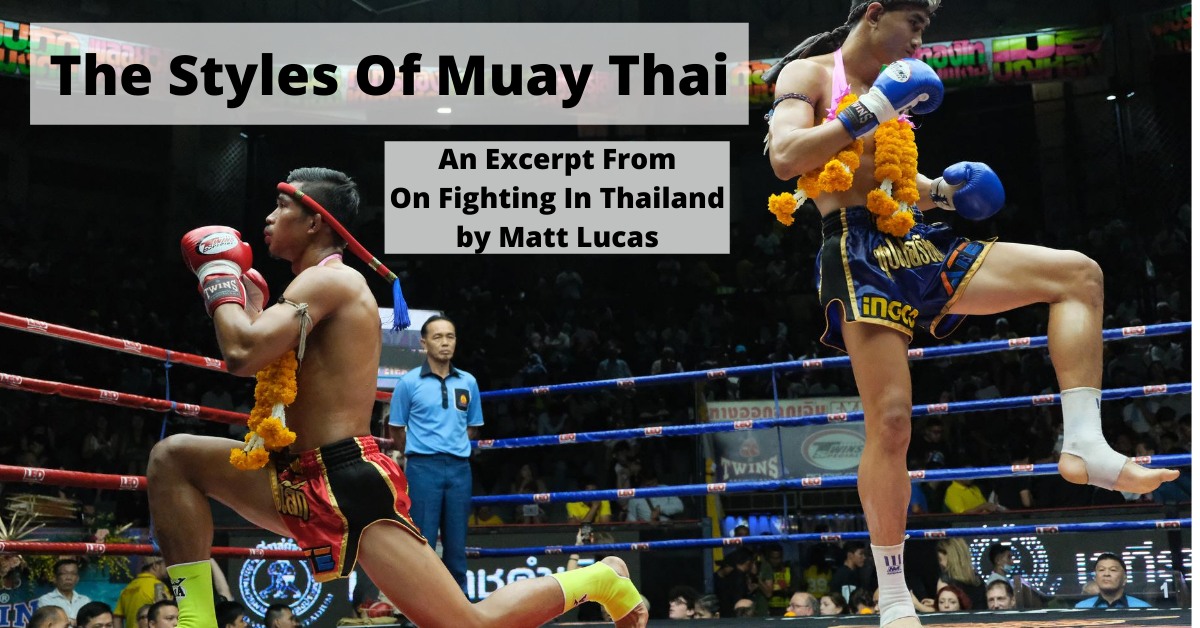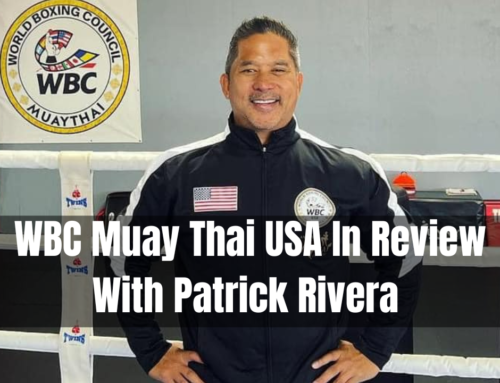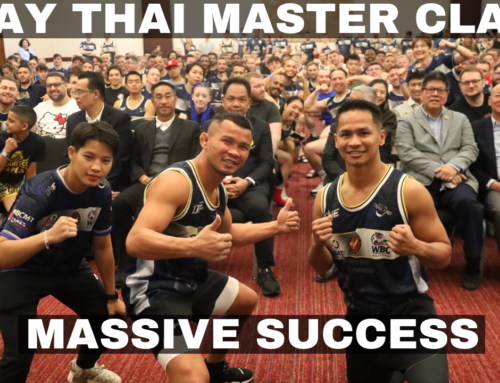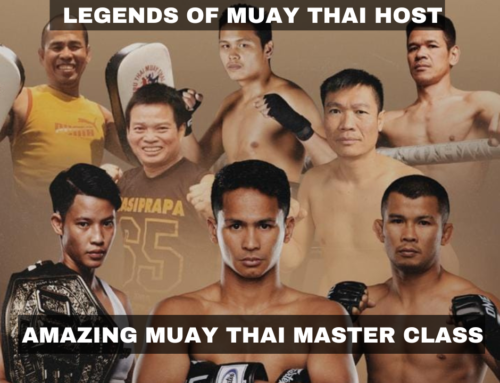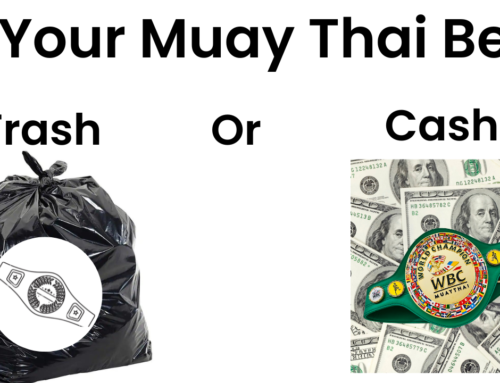Styles Make Fights
Excerpted from On Fighting In Thailand
The old adage for western boxing rings just as true for the science of eight limbs.
There are several different types of Muay Thai fighters; Muay Fimeu, Muay Mat, and Muay Khao. Technical fighters, technical brawlers and clinch and knee fighters, respectively. Like any style there are pros and cons to each.
The Fimeu fighter will use their superior timing to stay away from the powerful attacks of the Muay Mats and like matador with a bull will poke and score out a victory. If caught by the powerful attack of the Muay Mat or their base cut down by chopping leg kicks the Fimeu fighter will crumble.
The technical Muay Fimeu will try to evade the grasp of the clinch using lateral movement and or stalling techniques once in the clinch. They commonly attempt to sweep the Muay Khao off balance to prevent more draining knees from coming in. Often the Muay Fimeu will be unable to withstand the pressure and stamina of Muay Khaos.
Heavy handed punches will come in from the Muay Mats as they attempt to catch their elusive Muay Fimeu foes. The Muay Mat fighter is looking for a quick victory via thunderous punches especially against the quick and skilled Fimeu.
Muay Khao
Against Muay Khao fighters the Muay Mats, technical brawlers, will attempt to brace and or push off the Muay Khao as he comes in to throw heavy hands. The Muay Mat will also attempt to slow the forward momentum down with leg kicks. Generally, the power of a Muay Mat will fade quickly as their explosiveness is sapped away by knees. By closing down the distance the Muay Mat is unable to effectively punch or leg kick as well.
The Muay Khao fighter is best known for their endurance and will turn the match into a marathon. Both the technical fighting style of the Muay Fimeu and the heavy-handed approach of the Muay Mat can be neutralized with an aggressive walk forward Muay Khao style. The knee fighter strives to push forward on their opponent cornering them. Once trapped the Muay Khao will latch on and unleash a salvo of knees.
Each style of fighter has it’s place and often fighters will go through different styles during the course of their career. Both the Muay Mat and Muay Khao fighters tend to take heavy damage, to their bodies, and to their chins and so will often switch to the longer lasting style of the Muay Fimeu.
The Muay Khao style is developed over countless hours engaging in the clinch. This is not something that can be achieved quickly, one of the reasons why the style is not seen in the west. Every day Muay Thai fighters must engage in the clinch not only to improve their technical abilities but also increases their stamina. As stated, before knee fighters are well known for their unlimited stamina and will power.
The Muay Khao style relies on an ability to grind out the win. Steady constant pressure is necessary and the Muay Khao trudges on like a juggernaut. Ultimately the biggest weapon in the Muay Khaos’ arsenal isn’t their knees, their clinch, or their stamina. The Muay Khaos’ secret to success is having more will power. Sheer determination in a fight is what differentiates a Muay Khao from other styles of fighters.
Clinching is one of the most overlooked aspects of Muay Thai in the west. However, it is one of the most important aspects of Muay Thai in Thailand. Stadium judges score knees and close combat very highly and the ability to stay balanced, throw elbows, and spear in the knees can earn a fighter a decision in a close fight.
There are a variety of reasons why westerners don’t engage in the plum, or clinch. The scoring criteria in the west, especially in America, doesn’t highly value the skill as many of the judges and referees are improperly trained. Getting good in the clinch takes time and skilled training partners, two things that can be lacking at gyms in America. Unsurprisingly many westerners come to Thailand and while decent outside fighters, will easily get destroyed in the clinch by even a mediocre Thai fighter.
The Importance of Clinching
The importance of the clinch cannot be emphasized highly enough. The large stadiums such as Rajadamnern, Lumpinee, Omnoi and others are built around a scoring system that highly favors knee fighters. This is because the scoring is geared towards fighters that become stronger as they continue. Rather than a sprint, bouts are judged holistically, favoring marathon fighters that finish confidently. Engaging in the clinch can be physically taxing on a fighter. It requires intense stamina along with a super strong core to stomach the hard knees that can pierce in.
While the three-round fight doesn’t favor the clinch as much, it is still very important. Referees will generally be quicker to break up the clinch, but you’ll often see clinch fighters still able to score devastating knees in the clinch. A leaky gas tank in a three-round fight can be especially problematic as the fighters only have a limited amount of time to fight and wow the judges.
Often, you’ll see fighters clinch up after being hurt on the outside. Being adept at the clinch gives them time to recover while potentially still scoring points. A hard head shot can be turned around with pounding knees to the mid-section. It can also protect them from getting damaged on the outside with subsequent punches. Thus, clinching is also a form of effective defense for an injured fighter.
Learning To Clinch
These days everyone wants to streamline their learning. It is about learning as fast and efficiently as possible. The rise of this fast-paced culture has all sorts of tutorial videos and gimmicks for quick learning. Sadly, no amount of YouTube learning will adequately teach you the hands on feeling of the clinch. Learning how your body moves against another’s is something that must be directly experienced. While videos and instruction can help, there is no replacement from daily practice.
There are a variety of facets of the clinch that are important to learn; entry in the clinch, sweeps and off balances, and grabs and locks.
Entry into the clinch can be very tentative at first. In the first exchanges of the fight, it is very difficult for the Muay Khao to close in. This is largely due to issues of timing. The opponent will be on guard and the rhythm of the fight will yet to be established. As the fight progresses walking down an opponent becomes easier. That isn’t to say that it is not without dangers. A Nak Fimeu can easily side step or throw an elbow to prevent the forward momentum of a Muay Khao. Likewise, a Muay Mat can throw a well-timed uppercut to halt the knee fighter. Clinching then isn’t just about the mechanics of being in the clinch it is also the mechanics of entry. This again is something that must be practiced over and over and over. Continual knee sparring acquaints one with entry into the clinch.
Balance and throws are important when in the clinch. If the body is not positioned square to the opponent, it becomes easy to throw and or off balance. Some boxers are particularly adept at this, such as Superbank T Ded 99 or Seanchai PK Saenchai Muay Thai gym. Being able to read when a throw is coming and being prepared for it is a matter of experience as there are a variety of throws and sweeps. An opponent can target the leg stepping outside of it for a throw or they can push the leg out to off balance.
Locks and grabs vary as well. The obvious and most classic lock is the lock around the neck. This dominant position is highly favored, and the knee fighter will be able to break the opponent’s posture to land devastating knees to the head. However, there are also body locks and in between locks. Body locks aren’t favored as highly because they aren’t seen as scoring that highly. Other locks include arm traps, driving the head into the neck, and pushing the head back with the hands.
Defense In The Clinch
A good clincher must be able to defend in the clinch along with attack. The foundation for a strong clinch defense is having a strong core. Having a durable structure allows the knee fighter to press on despite having taken hard knees.
Positioning the leg across the waist is a classic defensive measure as is wrapping the legs around and opponent. Getting to the side of a boxer also allows for a stronger defense. Other defenses against the clinch including pushing off and side stepping.
Before entry into the clinch boxers must have strong iron like necks and the ability to ward off the incoming grasps. This is mainly honed through practice.
Problems with Muay Khao
Being a strong knee fighter will get you far in the sport of Muay Thai, but it is not the end all be all. There are potential holes in the knee fighter’s game. One of them is that they can develop tunnel vision. With a targeted vision, they move forward without seeing the larger picture around them. This can lead the Knee Fighter to chase an opponent around the ring, being picked off, especially if the Muay Khao is unable to cut off the ring. Having to take damage to enter the clinch also means that their chin can weaken over time and the knee fighter must have a lot of durability to continue with their career and the style of fighting.
Knee fighting is also most strongly suited towards boxers that are tall and skinny. With their exaggerated limbs, tall boxers can knee from afar. Boxers with lower wider builds have a harder time pushing into the clinch on taller fighters and generally enter the clinch via lower scoring body locks. That is not to say that shorter fighters are unable to become proficient knee fighters but that taller boxers have a natural height and range advantage.
Fighting is about entertainment and the grinding style of the knee fighter can be boring to watch. It does not contain the technical brilliance of the Muay Fimeu’s beautiful moves nor the highlight punch knock outs of the Muay Mat. The knee fighter trudges forward like a juggernaut hoping to steamroll their way to victory. This attitude can become dull if the boxer is unable to recognize the holes in their game and or are unable to adapt to the bout.
Despite some of the weaknesses of the Muay Khao it still is a very, very successful style of fighting in Thailand and one that is adopted by the top fighters in the world. Its effectiveness has been proven by countless matches and contests and like the Muay Khao continues to move its way forward towards victory.
Muay Mat
Technical brawlers, or Muay Mat (Muay Fist), use heavy handed attacks and low kicks to undo their opponents. Generally known for being explosive they are capable of ending the bout quickly by KO.
By loading up their punches and staying aggressive Muay Mat fighters can tire and take out their opponents quickly. They are quick to jump on their foes as soon as the opening bell rings.
Famous Muay Mat fighters include Pornsanae Sitmonchai, Sagat Petchyindee, Liam Harrison, Yodlekpetch Tded 99, Anuwat Kaewsamrit, etc.
Boxing and Leg Kicks
The boxing for Muay Mat fighters differs on the individual fighters. There are some commonalities though especially as the punches are used to set up the leg kicks.
Many Muay Mat fighters will use a broken rhythm. They attack, pause, and attack again. The rhythm is not always fluid to disrupt the timing and potential defenses of their opponent.
Other Muay Mat will use bread and butter techniques, especially the jab, hook, and cross. The jab is used as a measuring device. The hook is thrown to torque the body and set up the leg kick. The cross is used as a power punch to break the opponent’s head and or body.
The boxing of Muay Mat fighters tends to be heavy handed and powerful. They will rarely set up power punches but instead throw 100% power 100% of the time.
The leg kicks of Muay Mat will also differ. Many will jump into their leg kicks. This adds extra power and creates a lot of visual flair. The leg will come and then chop down on the thigh in an arc.
Another common leg kick is booting the leg almost straight up. This fast stinging style can smart and is meant as a tempo disrupting technique. Liam Harrison out of the UK uses this style of kicking often.
Defense
Muay Mat style and defense are not generally synonymous. Muay Mat fighters are known more for taking a shot, or two, to give one back. They generally are known for absorbing rather than blocking, catching, and or sweeping. However, to defend against the clinch they will often press out or push the opponent away to stay out of the clinch and to stay in punch and kicking range.
Problems with Muay Mat
Because of the heavy handed style, and the desire to “jump” on the opponent early, most Muay Mat fighters do not have good stamina. The general game plan is to win by knock out and so going to a points decision does not bode well for them. If the opponent can withstand the initial storm, they can usually eek out a victory. Wrapping up Muay Mat fighters in the clinch is a sure way to drain them for the Muay Khao boxer. Technical fighters can use their timing to stay out of range and control the game.
The Muay Mat style is very popular. While it doesn’t make for long lasting careers, due to all the damage taken, it has a lot of fan appeal. This makes it very good for entertainment shows and fighting outside of the traditional Thai stadiums.
Muay Fimeu
Technical fighters, or Muay Fimeu, are considered the most beautiful of fighters. By honing their craft, they display superior skills in the ring and can outpoint their opponents easily. There have been a host of Muay Fimeu fighters that have achieved fame over the years including,
Samart Payakaroon, Saenchai PK Saenchai Muay Thai Gym, Namsaknoi Yudthagarngamtorn, Sam-A Gaiyanghadao, and Nong-O Gaiyanghadao.
Rhythm and Timing
There are a few things that make technical fighters stand out. A real highlight is their understand of timing and technique. Every bout goes at a certain cadence and the Muay Fimeu immediately sets the tone for the fight. They control their opponents’ rhythm by attacking them at their speed. Their superior sense of timing also have them blocking and evading appropriately.
Footwork
One of the major differences that set technical fighters apart is their use of footwork. This can be seen in their ability to sidestep and appropriately use angles. Muay Mat and Muay Khao fighters generally walk forward. Muay Mat fighters being heavy on their feet to land the big shots and Muay Khao fighters walking in one direction to get into the clinch. Technical fighters use their footwork to dance around their opponent. Saenchai PK Saenchai Muay Thai Gym is an excellent example of superior footwork to control his opponent.
Controlling The Game And Scoring
Another of the hallmarks of the Muay Fimeu is their ability to control the game and score appropriately. They know the exact score in their heads and constantly are looking for cues of winning, and or losing. By having their finger on the pulse of the fight they know when they need to sprint ahead or can relax in the fight.
Tactically controlling the game usually means protecting a lead. This is often done by either using the push kick and jab to keep the opponent at bay or by wrapping them up in the clinch. Stalling techniques in the clinch are used to prevent the opponent from scoring.
Counter Fighting And Defense
Muay Fimeu fighters place a heavy emphasis on defense. Because of that and their understanding of timing, they tend to counter fight. Waiting for their opponent to strike they block and retaliate, guiding the bout like a matador. Counter fighting is generally done by backward movement. However, it can be done by sidestepping and using angles.
Problems With The Muay Fimeu Fighter
While technically brilliant the Muay Fimeu fighter generally plays it safe and is looking for the easiest way to get the win while taking the least amount of damage. This can make for lackluster fights. Also, the tendency to move backward does not do well at the entertainment shows with their desire for clashes. Wrapping up the opponent constantly or protecting the points is not fan friendly.
Muay Fimeu fighters do very well at the traditional stadiums where scoring is more important than anything else.
With the sport moving increasingly in the entertainment direction this style of fighting is in the most danger of dying out.
Get More from On Fighting In Thailand: A Guide To The Sport In The Motherland.

